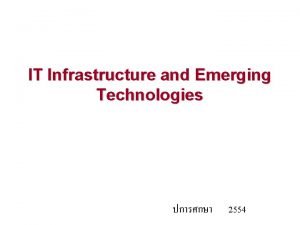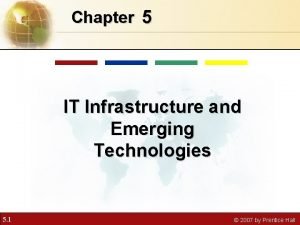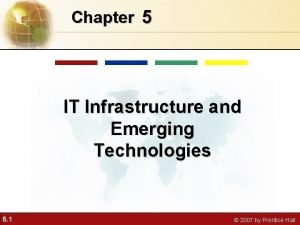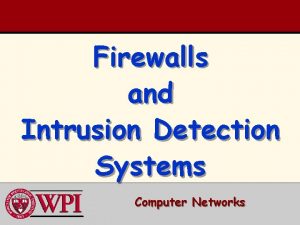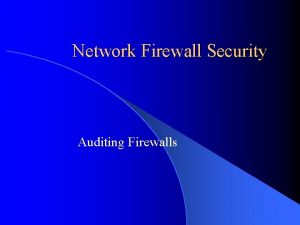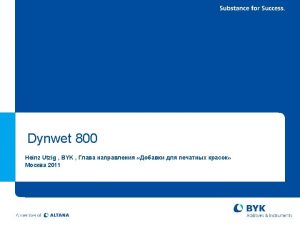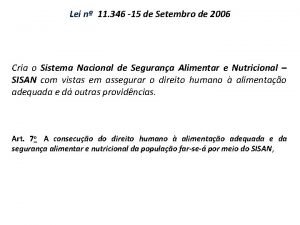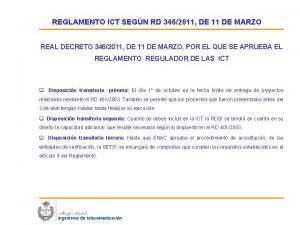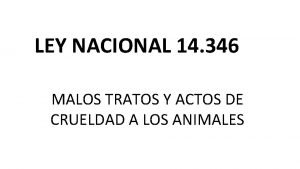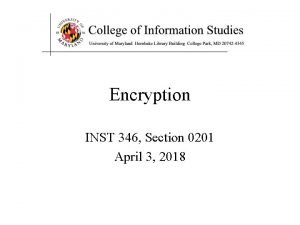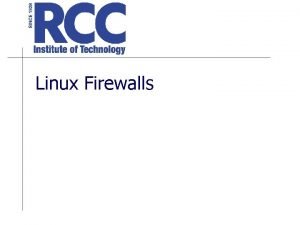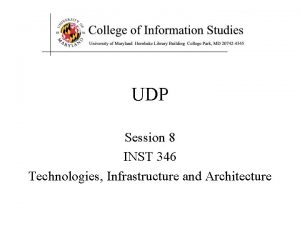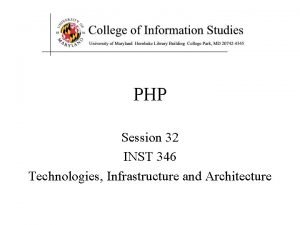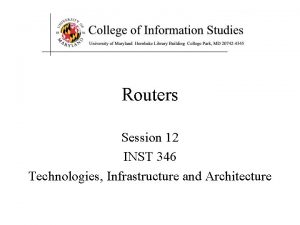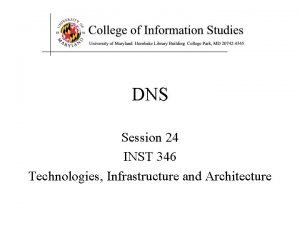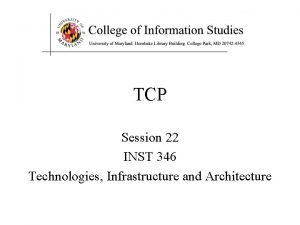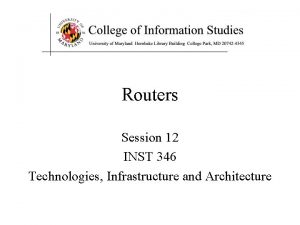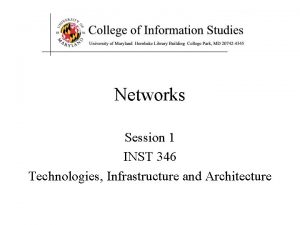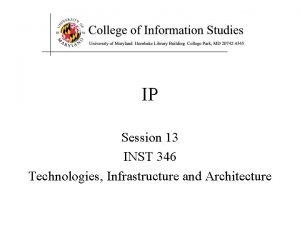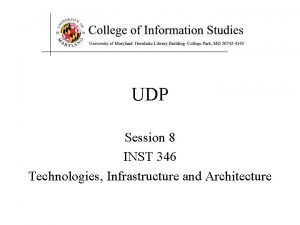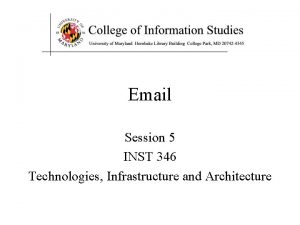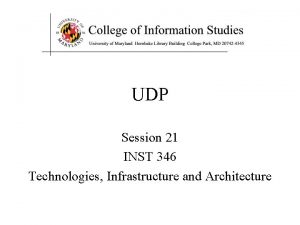Firewalls Session 20 INST 346 Technologies Infrastructure and

















- Slides: 17

Firewalls Session 20 INST 346 Technologies, Infrastructure and Architecture

Review • Homework 4 • Lab 4 2

Muddiest Points • CDMA – GSM is actually now CDMA (in 3 G) • Loss reasons other than buffer overflow 3

Goals for Today • Firewalls • Gateways • Deep packet inspection • Exam 2 preparation

Firewalls firewall isolates organization’s internal net from larger Internet, allowing some packets to pass, blocking others administered network public Internet trusted “good guys” untrusted “bad guys” firewall

Firewalls: why prevent denial of service attacks: § SYN flooding: attacker establishes many bogus TCP connections, no resources left for “real” connections prevent illegal modification/access of internal data § e. g. , attacker replaces CIA’s homepage with something else allow only authorized access to inside network § set of authenticated users/hosts three types of firewalls: § stateless packet filters § stateful packet filters § application gateways

Stateless packet filtering Should arriving packet be allowed in? Departing packet let out? § internal network connected to Internet via router firewall § router filters packet-by-packet, decision to forward/drop packet based on: • source IP address, destination IP address • TCP/UDP source and destination port numbers • ICMP message type • TCP SYN and ACK bits

Stateless packet filtering: example § example 1: block incoming and outgoing datagrams with IP protocol field = 17 and with either source or dest port = 23 • result: all incoming, outgoing UDP flows and telnet connections are blocked § example 2: block inbound TCP segments with ACK=0. • result: prevents external clients from making TCP connections with internal clients, but allows internal clients to connect to outside.

Stateless packet filtering: more examples Policy Firewall Setting No outside Web access. Drop all outgoing packets to any IP address, port 80 No incoming TCP connections, except those for institution’s public Web server only. Drop all incoming TCP SYN packets to any IP except 130. 207. 244. 203, port 80 Prevent Web-radios from eating up the available bandwidth. Drop all incoming UDP packets except DNS and router broadcasts. Prevent your network from being used for a smurf Do. S attack. Drop all ICMP packets going to a “broadcast” address (e. g. 130. 207. 255). Prevent your network from being tracerouted Drop all outgoing ICMP TTL expired traffic

Access Control Lists ACL: table of rules, applied top to bottom to incoming packets: (action, condition) pairs action source address dest address allow 222. 22/16 outside of 222. 22/16 allow outside of 222. 22/16 deny all 222. 22/16 outside of 222. 22/16 protocol source port dest port flag bit TCP > 1023 80 TCP 80 > 1023 ACK UDP > 1023 53 --- UDP 53 > 1023 ---- all all any

Stateful packet filtering § stateless packet filter: heavy handed tool • admits packets that “make no sense, ” e. g. , dest port = 80, ACK bit set, even though no TCP connection established: action allow source address dest address outside of 222. 22/16 protocol source port dest port flag bit TCP 80 > 1023 ACK § stateful packet filter: track status of every TCP connection • track connection setup (SYN), teardown (FIN): determine whether incoming, outgoing packets “makes sense” • timeout inactive connections at firewall: no longer admit packets

Stateful packet filtering ACL augmented to indicate need to check connection state table before admitting packet action source address dest address proto source port dest port allow 222. 22/16 outside of 222. 22/16 TCP > 1023 80 allow outside of 222. 22/16 TCP 80 > 1023 ACK allow 222. 22/16 UDP > 1023 53 --- allow outside of 222. 22/16 UDP 53 > 1023 ---- deny all all all 222. 22/16 outside of 222. 22/16 flag bit check conxion any x x

Application gateways § filter packets on host-to-gateway application data as well telnet session as on IP/TCP/UDP fields. § example: allow select internal users to telnet outside application gateway router and filter gateway-to-remote host telnet session 1. require all telnet users to telnet through gateway. 2. for authorized users, gateway sets up telnet connection to dest host. Gateway relays data between 2 connections 3. router filter blocks all telnet connections not originating from gateway.

Limitations of firewalls, gateways § IP spoofing: router can’t know if data “really” comes from claimed source § if multiple app’s. need special treatment, each has own app. gateway § client software must know how to contact gateway. • e. g. , must set IP address of proxy in Web browser § filters often use all or nothing policy for UDP § tradeoff: degree of communication with outside world, level of security § many highly protected sites still suffer from attacks

Intrusion detection systems § packet filtering: • operates on TCP/IP headers only • no correlation check among sessions § IDS: intrusion detection system • deep packet inspection: look at packet contents (e. g. , check character strings in packet against database of known virus, attack strings) • examine correlation among multiple packets • port scanning • network mapping • Do. S attack

Intrusion detection systems multiple IDSs: different types of checking at different locations firewall internal network IDS sensors Web DNS server FTP server Internet demilitarized zone

Exam 2
 It infrastructure and emerging technologies
It infrastructure and emerging technologies It infrastructure and emerging technologies
It infrastructure and emerging technologies Emerging technology chapter 2
Emerging technology chapter 2 It infrastructure and emerging technologies
It infrastructure and emerging technologies Computer hardware platforms in it infrastructure
Computer hardware platforms in it infrastructure Ids sensors
Ids sensors Auditing firewall security
Auditing firewall security Ist 346
Ist 346 Byk 346
Byk 346 Accessory nerve xi
Accessory nerve xi 427 266 to the nearest ten thousand
427 266 to the nearest ten thousand Lei 11.346/2006
Lei 11.346/2006 348 rounded to the nearest ten
348 rounded to the nearest ten Rd 346 2011
Rd 346 2011 Stats-346
Stats-346 Ley 14 346
Ley 14 346 Cipher of 346
Cipher of 346 Linux firewalls
Linux firewalls

